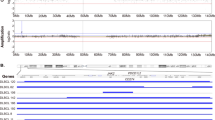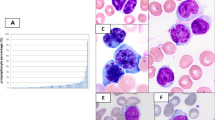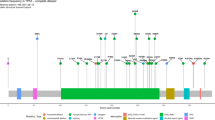Abstract
Anaplastic large-cell lymphoma (ALCL), as defined in the World Health Organization, is a heterogeneous category in which a subset of cases is associated with the t(2;5)(p23;q35) or variant translocations resulting in overexpression of anaplastic lymphoma kinase (ALK). p53 has not been assessed in currently defined subsets of ALCL tumors. In this study, we assessed ALK+ and ALK− ALCL tumors for p53 gene alterations using PCR, single-strand conformation polymorphism and direct sequencing methods. We also immunohistochemically assessed ALCL tumors for p53 expression. Three of 36 (8%) ALCL tumors (1/14 ALK+, 2/22 ALK−) with adequate DNA showed p53 gene mutations. By contrast, p53 was overexpressed in 36 of 55 (65%) ALCL tumors (16 ALK+, 20 ALK−). p21, a target of p53, was expressed in 15 of 31 (48%) ALCL tumors including seven of 15 (47%) p53-positive tumors. p21 expression in a subset of ALCL suggests the presence of functional p53 protein. Apoptotic rate was significantly higher in p53-positive than p53-negative tumors (mean 2.78 vs 0.91%, P=0.0003). We conclude that the p53 gene is rarely mutated in ALK+ and ALK− ALCL tumors. Nevertheless, wild-type p53 gene product is commonly overexpressed in ALCL and may be functional in a subset of these tumors.
This is a preview of subscription content, access via your institution
Access options
Subscribe to this journal
Receive 12 print issues and online access
$259.00 per year
only $21.58 per issue
Buy this article
- Purchase on Springer Link
- Instant access to full article PDF
Prices may be subject to local taxes which are calculated during checkout





Similar content being viewed by others
References
Delsol G, Ralfkiaer E, Stein H, Wright D, Jaffe ES . Anaplastic large cell lymphoma. In: Jaffe ES, Harris NL, Stein H, Vardiman JW (eds). World Health Organization Classification of Tumours. Pathology and Genetics of Tumors of Haematopoietic and Lymphoid Tissues. Lyon, France: IARC Press, 2001, pp 230–235.
Morris SW, Kirstein MN, Valentine MB, Dittmer KG, Shapiro DN, Saltman DL et al. Fusion of a kinase gene, ALK, to a nucleolar protein gene, NPM, in non-Hodgkin's lymphoma. Science 1994; 263: 1281–1284.
Morris SW, Naeve C, Mathew P, James PL, Kirstein MN, Cui X et al. ALK, the chromosome 2 gene locus altered by the t(2; 5) in non-Hodgkin's lymphoma, encodes a novel neural receptor tyrosine kinase that is highly related to leukocyte tyrosine kinase (LTK). Oncogene 1997; 14: 2175–2188.
Duyster J, Bai RY, Morris SW . Translocations involving anaplastic lymphoma kinase (ALK). Oncogene 2001; 20: 5623–5637.
Inghirami G, Macri L, Cesarman E, Chadburn A, Zhong J, Knowles DM . Molecular characterization of CD30+ anaplastic large-cell lymphoma: high frequency of c-myc proto-oncogene activation. Blood 1994; 83: 3581–3590.
Chilosi M, Doglioni C, Magalini A, Inghirami G, Krampera M, Nadali G et al. p21/WAF1 cyclin-kinase inhibitor expression in non-Hodgkin's lymphomas: a potential marker of p53 tumor-suppressor gene function. Blood 1996; 88: 4012–4020.
Chilosi M, Doglioni C, Yan Z, Lestani M, Menestrina F, Sorio C et al. Differential expression of cyclin-dependent kinase 6 in cortical thymocytes and T-cell lymphoblastic lymphoma/leukemia. Am J Pathol 1998; 152: 209–217.
Rassidakis GZ, Sarris AH, Herling M, Ford RJ, Cabanillas F, McDonnell TJ et al. Differential expression of BCL-2 family proteins in ALK-positive and ALK-negative anaplastic large cell lymphoma of T/null-cell lineage. Am J Pathol 2001; 159: 527–535.
Rassidakis GZ, Claret FX, Lai R, Zhang Q, Sarris AH, McDonnell TJ et al. Expression of p27(Kip1) and c-Jun activation binding protein 1 are inversely correlated in systemic anaplastic large cell lymphoma. Clin Cancer Res 2003; 9: 1121–1128.
Rassidakis GZ, Lai R, Herling M, Cromwell C, Schmitt-Graeff A, Medeiros LJ . Retinoblastoma protein is frequently absent or phosphorylated in anaplastic large-cell lymphoma. Am J Pathol 2004; 164: 2259–2267.
Vousden KH, Lu X . Live or let die: the cell's response to p53. Nat Rev Cancer 2002; 2: 594–604.
Levine AJ, Momand J, Finlay CA . The p53 tumour suppressor gene. Nature 1991; 351: 453–456.
Hollstein M, Sidransky D, Vogelstein B, Harris CC . p53 mutations in human cancers. Science 1991; 253: 49–53.
Wu X, Bayle JH, Olson D, Levine AJ . The p53–mdm-2 autoregulatory feedback loop. Genes Dev 1993; 7: 1126–1132.
Oliner JD, Pietenpol JA, Thiagalingam S, Gyuris J, Kinzler KW, Vogelstein B . Oncoprotein MDM2 conceals the activation domain of tumour suppressor p53. Nature 1993; 362: 857–860.
Sanchez-Beato M, Sanchez-Aguilera A, Piris MA . Cell cycle deregulation in B-cell lymphomas. Blood 2003; 101: 1220–1235.
Sherr CJ, Roberts JM . CDK inhibitors: positive and negative regulators of G1-phase progression. Genes Dev 1999; 13: 1501–1512.
Soussi T, Beroud C . Assessing TP53 status in human tumours to evaluate clinical outcome. Nat Rev Cancer 2001; 1: 233–240.
Rassidakis GZ, Jones D, Thomaides A, Sen F, Lai R, Cabanillas F et al. Apoptotic rate in peripheral T-cell lymphomas: a study using a tissue microarray with validation on full tissue sections. Am J Clin Pathol 2002; 118: 328–334.
Quintanilla-Martinez L, Kremer M, Keller G, Nathrath M, Gamboa-Dominguez A, Meneses A et al. p53 Mutations in nasal natural killer/T-cell lymphoma from Mexico: association with large cell morphology and advanced disease. Am J Pathol 2001; 159: 2095–2105.
Cesarman E, Inghirami G, Chadburn A, Knowles DM . High levels of p53 protein expression do not correlate with p53 gene mutations in anaplastic large cell lymphoma. Am J Pathol 1993; 143: 845–856.
Matsushima AY, Cesarman E, Chadburn A, Knowles DM . Post-thymic T cell lymphomas frequently overexpress p53 protein but infrequently exhibit p53 gene mutations. Am J Pathol 1994; 144: 573–584.
Pescarmona E, Pignoloni P, Santangelo C, Naso G, Realacci M, Cela O et al. Expression of p53 and retinoblastoma gene in high-grade nodal peripheral T-cell lymphomas: immunohistochemical and molecular findings suggesting different pathogenetic pathways and possible clinical implications. J Pathol 1999; 188: 400–406.
Villuendas R, Pezzella F, Gatter K, Algara P, Sanchez-Beato M, Martinez P et al. p21WAF1/CIP1 and MDM2 expression in non-Hodgkin's lymphoma and their relationship to p53 status: a p53+, MDM2−, p21− immunophenotype associated with missense p53 mutations. J Pathol 1997; 181: 51–61.
Shieh SY, Ikeda M, Taya Y, Prives C . DNA damage-induced phosphorylation of p53 alleviates inhibition by MDM2. Cell 1997; 91: 325–334.
Canman CE, Lim DS, Cimprich KA, Taya Y, Tamai K, Sakaguchi K et al. Activation of the ATM kinase by ionizing radiation and phosphorylation of p53. Science 1998; 281: 1677–1679.
Chehab NH, Malikzay A, Appel M, Halazonetis TD . Chk2/hCds1 functions as a DNA damage checkpoint in G(1) by stabilizing p53. Genes Dev 2000; 14: 278–288.
Hirao A, Kong YY, Matsuoka S, Wakeham A, Ruland J, Yoshida H et al. DNA damage-induced activation of p53 by the checkpoint kinase Chk2. Science 2000; 287: 1824–1827.
Bartel F, Taubert H, Harris LC . Alternative and aberrant splicing of MDM2 mRNA in human cancer. Cancer Cell 2002; 2: 9–15.
Maya R, Balass M, Kim ST, Shkedy D, Leal JF, Shifman O et al. ATM-dependent phosphorylation of Mdm2 on serine 395: role in p53 activation by DNA damage. Genes Dev 2001; 15: 1067–1077.
Tao W, Levine AJ . P19(ARF) stabilizes p53 by blocking nucleo-cytoplasmic shuttling of Mdm2. Proc Natl Acad Sci USA 1999; 96: 6937–6941.
Bernardi R, Scaglioni PP, Bergmann S, Horn HF, Vousden KH, Pandolfi PP . PML regulates p53 stability by sequestering Mdm2 to the nucleolus. Nat Cell Biol 2004; 6: 665–672.
Chene P . Inhibiting the p53–MDM2 interaction: an important target for cancer therapy. Nat Rev Cancer 2003; 3: 102–109.
Acknowledgements
Dr GZ Rassidakis is a recipient of an Odyssey Program Special Fellowship from The University of Texas MD Anderson Cancer Center.
Author information
Authors and Affiliations
Corresponding author
Additional information
This study was presented in part at the 93rd United States and Canadian Academy of Pathology meeting, Vancouver, BC, Canada, March 6–12, 2004
Supplementary Information
Supplementary Information accompanies the paper on the Leukemia website (http://www.nature.com/leu).
Supplementary information
Rights and permissions
About this article
Cite this article
Rassidakis, G., Thomaides, A., Wang, S. et al. p53 gene mutations are uncommon but p53 is commonly expressed in anaplastic large-cell lymphoma. Leukemia 19, 1663–1669 (2005). https://doi.org/10.1038/sj.leu.2403840
Received:
Accepted:
Published:
Issue Date:
DOI: https://doi.org/10.1038/sj.leu.2403840
Keywords
This article is cited by
-
De novo generation of the NPM-ALK fusion recapitulates the pleiotropic phenotypes of ALK+ ALCL pathogenesis and reveals the ROR2 receptor as target for tumor cells
Molecular Cancer (2022)
-
Systemic, primary cutaneous, and breast implant-associated ALK-negative anaplastic large-cell lymphomas present similar biologic features despite distinct clinical behavior
Virchows Archiv (2019)
-
Breast implant-associated anaplastic large cell lymphoma in a Li-FRAUMENI patient: a case report
Diagnostic Pathology (2018)
-
Excess of NPM-ALK oncogenic signaling promotes cellular apoptosis and drug dependency
Oncogene (2016)
-
Evaluation of potential interactions between the metastasis-associated protein S100A4 and the tumor suppressor protein p53
Amino Acids (2011)



